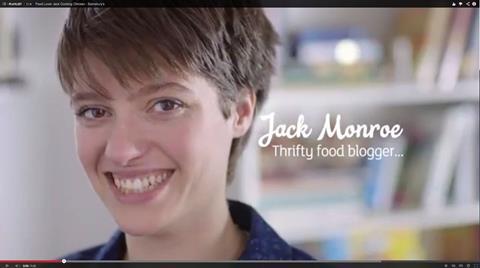How can retailers improve the way they work with bloggers? Jo Middleton, creator of the blog Slummy Single Mummy, explains what retailers should do.

Blogging today is big business. A few of the most popular names - Susie Lau in fashion, for instance, Jack Monroe in food or Caroline Hirons in beauty - are now as well known in their chosen fields as any of the columnists in the national papers, and their followers are engaged and passionate about the topics they cover.
The most successful bloggers are popular through word of mouth and enjoy a strong influence over their readers and their purchasing decisions.
It’s a level of engagement some retailers can only dream of. So how can they tap into this talent and work effectively with relevant blogs?
While a handful of retailers - including Sainsbury’s, River Island and Topshop - have embraced working with bloggers, it’s a relatively new area and there is still a lot to learn.
What is clear is that digital marketing is about so much more than tweeting pictures of your latest products. It should be less about what retailers are communicating through their own platforms, and more about the buzz that they can get other people to generate.
Shareable content, viral videos - it’s all about creating a message that is not broadcast by the retailer, but that comes from the mouths of ordinary people who are trusted by their audience in a natural and authentic way that brands can’t always achieve.
Blogger outreach (working with bloggers to promote a product, project or message) can be a valuable part of this. So how can retailers reach out to bloggers to help boost business? Here are six simple principles to get you off to the best possible start.
1) Define your goals
It’s easy to fall into the trap of jumping on the blogger bandwagon just because everyone else seems to be doing it.
Nobody wants to get left behind, but you do need to be clear from the start about what needs to be achieved.
Retailers might want to build solid, long-term relationships with a small group of bloggers who can become active ambassadors for the brand, or they may want to raise as much awareness as possible about a particular event or product to maximise reach.
Whatever the case, it’s necessary to think about how these targets can ultimately help to drive sales - how will they be measured and how will the impact of the work be assessed? Securing coverage on 100 different blogs is all well and good, but to what end? Has it driven traffic to the brand’s website? Are more people visiting your stores?
2) Finding your bloggers
When you’re clear about what you want to achieve, the next question is how to achieve it.
There are thousands of blogs out there, so how do you know which ones are the best to work with?
This stage involves lots of research and reading, but it is essential in getting to know the people you want to work with.
Use listings such as eBuzzing or Cision and follow the trails from blogs you like to other bloggers through their blogroll or other links. Don’t just look at the statistics though - consider design, tone and professionalism and look at levels of social interaction and reader engagement. Do posts get a lot of comments? Are readers talking with the blogger on Twitter and Facebook?
3) Get expert help
Another option is to outsource this step to an external agency. There are plenty of them around offering a range of services from simply providing a list of potential bloggers to managing entire campaigns. This can be a good place to start if you are totally new, but make sure you use it purely as a springboard for building more personal relationships.
Rich Leigh, co-founder of blogger outreach service Bloggabase, says: “The personal touch goes a long way. Bloggers deserve more than being part of a list put together after a quick Google search and the scattergun pitching approach that usually follows.
“You don’t have to be a blogger’s best friend but you do have to do your research and tell them why your company is right for their readership.”
The third option is to use a blogger as your agent. This gives you the benefit of their inside knowledge and existing relationships, and can be cheaper than using an agency. Other bloggers are more likely to respond to someone from inside their community who they already know and trust. And the blogger you choose will often have insight into who would be a good fit for your campaign.
4) Making the initial approach
If you want to get the best response possible send personal, individual emails, addressing the blogger by name. Most bloggers say they prefer a retailer to make initial contact through a personal email than through social media, an event or a press release.
No blogger is going to expect you to be a life-long fan, but you should still take the time to read around a little bit, get an idea of the blogger’s interests and tailor your email accordingly.
“The brands I have most enjoyed working with are those who have taken time to get to know me,” says Philippa Moore, creator of the blog Skinny Latte Strikes Back. “They have made a really authentic alignment between my brand and theirs.
It hasn’t just been about engaging me for a one-off campaign, it’s been about building a connection over the long term.
“As a result I’ve come to feel like a valued member of their team and they have my loyalty in return.”
5) Be creative
Retailers need to put a little bit of thought into packaging their campaign into something that is going to excite and engage the bloggers you want to work with.
The same pitch isn’t going to appeal to everyone, so think hard about who you are targeting and what makes them tick.
Fritha Strickland writes the blog Tigerlilly Quinn and is at present number two in the HIBS100 home and interiors blog index. “I love it when a retailer comes to me with a really creative idea,” says Strickland.
“I recently did a collaboration with Made.com. They had taken the time to read my blog and then approached me with the idea of a guest post combined with an illustration for their site. Brands who do their research immediately go in my good books,” she adds.
Strickland is a professional illustrator as well as a blogger, so Made.com got its pitch spot-on by offering something it knew she would want to get involved in.
6) Keep it legal
The law and best practice is very clear when it comes to working with bloggers. Sponsored posts, according to Advertising Standards Authority regulations, should always be disclosed as such, making it clear to a reader that content has been paid for. Bloggers who have received a product or experience free in return for a review should disclose that as well.
Sally Whittle, founder of the Tots100 parent blogs network, says: “Don’t underestimate the importance of being open and honest with bloggers. In our research, around half of the bloggers we spoke to have been asked to do something unethical by a brand, whether it’s not disclosing a payment or not publishing a negative review.
“Bloggers do talk amongst themselves, meaning your reputation is being tarnished before you’ve even pitched someone,” Whittle cautions.
Build these six key ideas into your next blogger outreach campaign, coupled with an ongoing strategy focused on mutual benefit and support, and you should see a stronger, longer-lasting impact as a result.
Jo Middleton is director of media company Inside Scoop and writer of the multi-award winning blog Slummy Single Mummy. Follow Jo on Twitter at @mummyblogger.


























No comments yet